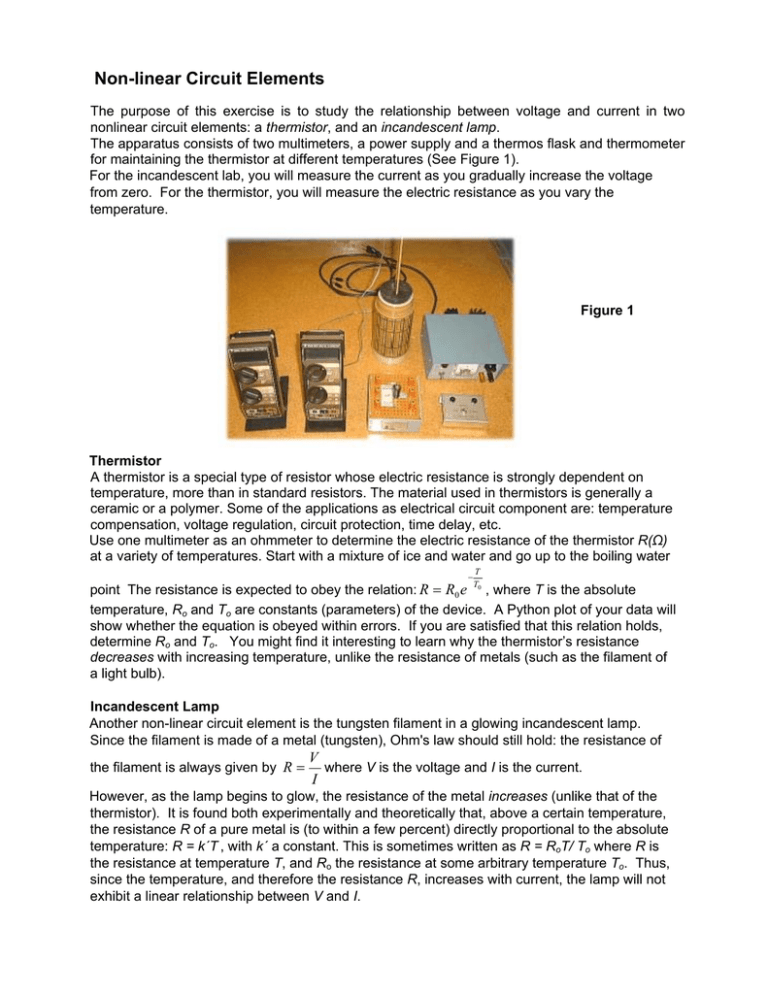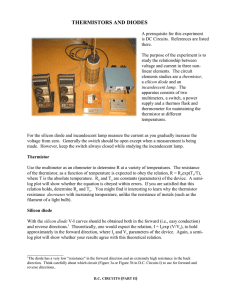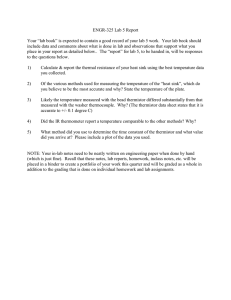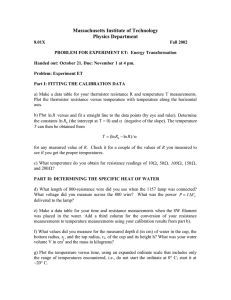Non-linear Circuit Elements
advertisement

Non-linear Circuit Elements The purpose of this exercise is to study the relationship between voltage and current in two nonlinear circuit elements: a thermistor, and an incandescent lamp. The apparatus consists of two multimeters, a power supply and a thermos flask and thermometer for maintaining the thermistor at different temperatures (See Figure 1). For the incandescent lab, you will measure the current as you gradually increase the voltage from zero. For the thermistor, you will measure the electric resistance as you vary the temperature. Figure 1 Thermistor A thermistor is a special type of resistor whose electric resistance is strongly dependent on temperature, more than in standard resistors. The material used in thermistors is generally a ceramic or a polymer. Some of the applications as electrical circuit component are: temperature compensation, voltage regulation, circuit protection, time delay, etc. Use one multimeter as an ohmmeter to determine the electric resistance of the thermistor R(Ω) at a variety of temperatures. Start with a mixture of ice and water and go up to the boiling water T T0 point The resistance is expected to obey the relation: R R0 e , where T is the absolute temperature, Ro and To are constants (parameters) of the device. A Python plot of your data will show whether the equation is obeyed within errors. If you are satisfied that this relation holds, determine Ro and To. You might find it interesting to learn why the thermistor’s resistance decreases with increasing temperature, unlike the resistance of metals (such as the filament of a light bulb). Incandescent Lamp Another non-linear circuit element is the tungsten filament in a glowing incandescent lamp. Since the filament is made of a metal (tungsten), Ohm's law should still hold: the resistance of the filament is always given by R V where V is the voltage and I is the current. I However, as the lamp begins to glow, the resistance of the metal increases (unlike that of the thermistor). It is found both experimentally and theoretically that, above a certain temperature, the resistance R of a pure metal is (to within a few percent) directly proportional to the absolute temperature: R = k´T , with k´ a constant. This is sometimes written as R = RoT/ To where R is the resistance at temperature T, and Ro the resistance at some arbitrary temperature To. Thus, since the temperature, and therefore the resistance R, increases with current, the lamp will not exhibit a linear relationship between V and I. Investigate the actual relationship between V and I for the lamp by gradually increasing the voltage. The readings should be taken across a full range of voltage up to 25 volts or so. Take several readings at low voltages (< 1 V) and currents (< 3mA) and also at high voltages (>20V). Plot your results in Python and do a data fitting assessment to see if they satisfy the relation: V k I a where V is the voltage, I is the current, k and a are constants. If this formula holds, determine k and a. a) How is the heat that you feel radiating from a hot body related to the temperature of the body? The answer to this question was given by the famous Stefan-Boltzmann law - the power radiated from unit area of any body at an absolute temperature T is given by: T n , where σ and n are universal constants (the same for all radiating bodies) and ε is a constant that depends on the particular radiating body. σ is the Stefan-Boltzmann constant. The voltage-current data you have gathered can now be used to determine the value of n. We can make the assumption that that when the filament reaches thermal equilibrium at higher temperatures, the electrical power fed into the lamp (VI) is almost entirely dissipated in the form of radiation Q emitted from the filament: Q = VI. Q is just multiplied by the area of the filament. Using the relation between V and I that you determined in part a) above, Q can be then written as a function of I (and constants). Similarly, T can be expressed as a function of R, which, being equal to V/I can also be expressed as a function of I (and constants). Eliminating I from these expressions for Q and for R yields the required relationship between the two. Assuming the constants are equal, determine n. b) Questions Why thermistors and metal resistors have different variations of resistance with temperature? The constant ε from Stefan-Boltzmann Law is called emissivity of the radiating body and takes values between 0 and 1. What is the meaning of ε = 0, ε = 1 and a value in-between? This guide sheet was revised and rewritten by Ruxandra M. Serbanescu in 2015. Previous version: TK 1998



